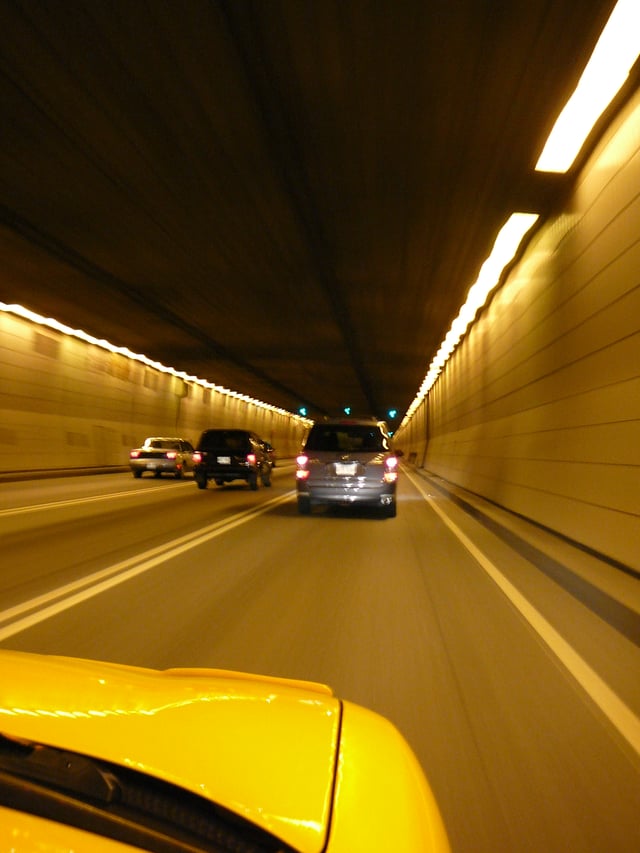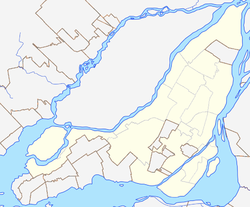Louis-Hippolyte Lafontaine Bridge–Tunnel

Louis-Hippolyte Lafontaine Bridge–Tunnel

| Overview | |
|---|---|
| Location | Montreal, Quebec, Canada |
| Route | Autoroute 25 |
| Crosses | St. Lawrence River |
| Operation | |
| Opened | March 11, 1967 (1967-03-11) |
| Traffic | 120,000[1] |
| Character | Limited access highway |
| Technical | |
| Length | 1,391 m (4,563.6 ft) (tunnel section) 409 m (1,341.9 ft) (causeway section) |
| No.of lanes | 6 |
| Tunnel clearance | 4.4 m (14 ft51⁄4 in) |
| Width | 37 m (121.4 ft) |
The Louis-Hippolyte Lafontaine Bridge–Tunnel (French: Pont-Tunnel Louis-Hippolyte-La Fontaine) is a highway bridge–tunnel running over and beneath the Saint Lawrence River. It connects the Montreal borough of Mercier–Hochelaga-Maisonneuve with the south shore of the river at Longueuil, Quebec.
Named after Lower Canada political reformer Louis-Hippolyte Lafontaine, the Lafontaine Tunnel is an immersed tube structure, measuring 1,391 m (4,563.6 ft) long. It carries the Autoroute 25 expressway and passes beneath the main shipping channel in the Saint Lawrence River immediately downstream from the Saint Lawrence Seaway. It surfaces on Île Charron (Îles de Boucherville at entrance/exit #1 of Autoroute 25), then continues by bridge to Longueuil. The bridge-tunnel sees about 120,000 daily crossings, of which 13% are trucks.[1] Its construction began in 1963 and it opened on March 11, 1967.[2][3]
| Overview | |
|---|---|
| Location | Montreal, Quebec, Canada |
| Route | Autoroute 25 |
| Crosses | St. Lawrence River |
| Operation | |
| Opened | March 11, 1967 (1967-03-11) |
| Traffic | 120,000[1] |
| Character | Limited access highway |
| Technical | |
| Length | 1,391 m (4,563.6 ft) (tunnel section) 409 m (1,341.9 ft) (causeway section) |
| No.of lanes | 6 |
| Tunnel clearance | 4.4 m (14 ft51⁄4 in) |
| Width | 37 m (121.4 ft) |
History
In 1960, the construction of the Trans-Canada Highway (TCH) through Quebec from the Ontario border to Rivière-du-Loup was announced. In Montreal, to avoid having to build a huge bridge that would have disfigured the city and destroyed a neighbourhood, engineers opted for the construction of a tunnel located under the Saint Lawrence River and dug a trench under the river bed and buried the tunnel sections 4.6 metres (15 ft) to 6.1 metres (20 ft) under the river bed.
A major four-year refurbishment of the tunnel is slated to begin in 2020.[1]
Specifications

Inside the tunnel
Each of the seven tunnel sections weighs 32,000 t (31,000 long tons; 35,000 short tons),[3] is 110 metres (360 ft) long, 37 metres (121 ft) wide and rises to a height of 8 metres (26 ft). In total, the bridge–tunnel is 1.8 kilometres (1.1 mi) long.
The tunnel was built with sections prefabricated in dry dock and then sunk in the river,[6] 24 metres (79 ft) below the surface of the water.
It is one of the largest prestressed concrete structures in the world and is the longest bridge-tunnel in Canada.[2]
See also
List of crossings of the Saint Lawrence River
List of bridges in Montreal

